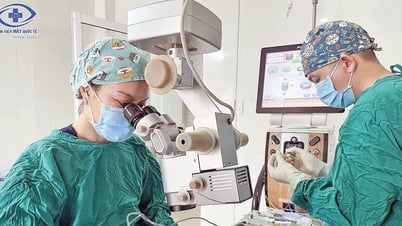Starting the day with health news , readers can also read more articles: This color earwax could be a sign of cancer; 4 bad effects on the knees when driving for too long ; 5 small habits to help lose weight without putting pressure on the body...
5 ways to maximize calcium absorption from milk
Calcium is an essential mineral that helps maintain strong bones, supports nerve function and muscle contraction. Although milk is a popular source of calcium, drinking milk alone may not ensure adequate calcium intake.
Many factors can significantly affect how well your body absorbs calcium from milk, from how it is prepared to how it is combined with other foods. There are a few ways to increase the calcium absorption of milk, thereby maximizing its health benefits.

Milk is one of the best sources of calcium.
PHOTO: AI
To increase the amount of calcium absorbed from milk, people can apply the following methods:
Drink warm milk. Warm milk can help the digestive process work more effectively, helping the body absorb nutrients, including calcium. This is because warm drinks help stimulate enzyme activity in the intestines, which can improve the ability to absorb nutrients.
Add turmeric to milk. Turmeric is a bright yellow spice known for its anti-inflammatory and antioxidant properties. Curcumin, the main active ingredient in turmeric, has been shown to have many benefits for gut health. This is because curcumin helps balance the microbiome and reduce inflammation. A healthy digestive system is important for absorbing nutrients, including calcium.
Combine milk with figs. Figs, especially dried figs, are a high-quality source of calcium. Fresh figs contain 35 mg of calcium per 100 grams, while dried figs contain about 162 mg. In addition to calcium, figs contain fiber and important minerals such as potassium and magnesium, which help support bone health.
Combining figs with milk can help increase overall calcium intake and provide many other nutrients that help strengthen bones. The next content of this article will be on the health page on April 8 .
Doctor: This color earwax could be a sign of cancer
An audiologist has revealed changes in earwax colour that you should never ignore as they could be a sign of cancer.
Expert Hannah Samuels, an audiologist at Boots Hearingcare Clinic (UK), has revealed that the color of earwax can be a warning sign of a serious health condition, even cancer .

The color of your earwax can be a warning sign of a serious health condition, even cancer.
Photo: AI
Earwax is a natural waxy substance produced by the ear that helps protect the sensitive parts of this organ from dirt and bacteria.
First, Dr. Hannah Samuels says that yellow or light brown earwax is considered normal and healthy. However, if your earwax changes color, you may have a health problem.
Red or bloody earwax is probably the most serious, warns Dr. Samuels. In mild cases, this is a sign of a minor injury to the ear or infection, but in rare cases, it can be a potential symptom of ear cancer.
Cancer Research UK warns that bleeding from the ear can be a sign of a tumour growing in the ear canal - the tube that connects the outer ear to the eardrum.
If the bleeding continues, it’s best to see a doctor, Dr. Samuels added. The next part of this article will be on the health page on April 8 .
4 bad effects on the knees when driving for too long
Driving frequently for long periods of time can lead to patellofemoral pain syndrome. This condition causes inflammation, persistent pain and affects mobility.
Patellofemoral pain syndrome causes pain in the front of the knee, especially around or behind the kneecap. This condition is often caused by overuse, weak thigh muscles, poor posture, or wearing shoes that do not fit your feet.

Driving a car for a long time can cause patellofemoral pain syndrome.
PHOTO: AI
For drivers or people who regularly drive cars, the cause of patellofemoral pain syndrome is due to the knee often being in a fixed bent position for a long time when driving, especially on long trips. This position puts pressure on the joint between the patella and the femur, increasing the risk of irritation or inflammation in this area.
Not only that, the legs also work harder because they have to step on the gas and brake. In addition, a seat that is too far or too close to the pedals also increases pressure on the knees.
Typical symptoms of this condition are a dull, aching pain in the front of the knee or around the kneecap. The pain is especially evident when exercising, climbing stairs, jogging, squatting or bending the knee for a long time.
To reduce pain and inflammation, people with patellofemoral pain syndrome can apply the following methods:
Stretch. If possible, drivers should take time to stretch their legs after every 30 minutes of driving. This will reduce stress on the knee joint, improve flexibility, and reduce stiffness.
When they reach their stop, they should get off the bus and walk for a few minutes. This will help stretch and reduce pressure on the back muscles and spine.
Knee strengthening exercises. Exercises that target the muscles around the knee, such as leg presses, squats, lunges, and calf raises, can also help relieve pain. In addition, stronger muscles around the knee will improve the stability of the knee during movement, thereby reducing the risk of future injury. Start your day with health news to see more of this article!
Source: https://thanhnien.vn/ngay-moi-voi-tin-tuc-suc-khoe-ket-hop-sung-voi-sua-giup-ich-dieu-gi-185250408000316503.htm







![[Photo] Panorama of the Opening Ceremony of the National Press Festival 2025](https://vphoto.vietnam.vn/thumb/1200x675/vietnam/resource/IMAGE/2025/6/20/6b835ee92c2c4df587af73cb2d1f4f5f)



















![[Photo] General Secretary To Lam chairs the 14th Central Military Commission Conference](https://vphoto.vietnam.vn/thumb/1200x675/vietnam/resource/IMAGE/2025/6/20/a9d25fc6dd664fb9a3757502f32e5db0)


























![[Maritime News] Wan Hai Lines invests $150 million to buy 48,000 containers](https://vphoto.vietnam.vn/thumb/402x226/vietnam/resource/IMAGE/2025/6/20/c945a62aff624b4bb5c25e67e9bcc1cb)














































Comment (0)